Harwoods Hole facts for kids
Quick facts for kids Harwoods Hole |
|
|---|---|

A caver being lowered into Harwoods Hole
|
|
| Location | South Island, New Zealand |
| Length | Height: 357 metres (1,171 ft) Opening: 50 metres (160 ft) |
| Hazards | Free fall |
Harwoods Hole is an amazing cave system found in the northwest of New Zealand's South Island. It's part of the beautiful Abel Tasman National Park. This cave is famous for having New Zealand's deepest straight drop, which is about 183 meters (600 feet) deep! People first explored it in 1958, many years after it was discovered.
Contents
How Harwoods Hole Formed
How did Harwoods Hole form? Long ago, water from a large area flowed into a stream. This stream then carved out a dry valley, creating the start of Harwoods Hole. Over time, the river changed its path. Now, water enters the cave through special holes called sinkholes and other dry valleys nearby. This water picks up a mineral called calcite from the rocks. When it enters the cave, the calcite settles, slowly filling parts of the hole instead of making it bigger.
A Look at Harwoods Hole's History
Harwoods Hole is one of several important cave systems in Takaka Hill. This area is located between Golden Bay and Tasman Bay / Te Tai-o-Aorere. The cave starts with a wide opening about 50 meters (164 feet) across. From there, it drops straight down for 183 meters (600 feet). This makes it New Zealand's deepest vertical shaft. Deeper inside, it connects with another cave called Starlight Cave. The long rope descent into Harwoods Hole is a very exciting part of the caving adventure. The total depth of Harwoods Hole, from its entrance to its lowest outlet, is 357 meters (1,171 feet).
Discovering the Hole
A man named Henry Harwood (1844–1927), along with John Horton and Thomas Manson, found the Canaan Downs area. They also discovered Harwoods Hole. However, no one went inside it right away. The cave remained untouched until the summer of 1958/59. That's when seven brave cavers decided to explore it. They used a large, home-built winch that weighed 255 kilograms (562 pounds). The first person was lowered into the hole on December 28, 1958. After this first exploration, Harwoods Hole became the deepest explored cave in New Zealand. Later, Nettlebed Cave in the nearby Mount Arthur region broke this record.
Further Exploration and Challenges
The next summer, 21 cavers explored Harwoods Hole even more. This team also wanted to find where the underground stream flowed out. They thought Gorge Creek at East Takaka might be the outlet because the water flow matched. They released green dye inside Harwoods Hole. Soon, the dye appeared at Starlight Cave, which the cavers named because Gorge Creek emerged there. This confirmed the connection. A narrow passage was made wider using explosives, creating a path for cavers from Harwoods Hole to East Takaka.
On January 4, 1960, a sad event happened at Harwoods Hole. Peter Lambert, who was leading the caving trip, was hurt by falling rocks. He was a member of the New Zealand Speleological Society. A pile of stones, called a cairn, was built at the bottom of the shaft. Lambert's helmet was placed on it as a memorial.
How to Visit Harwoods Hole
Near the top of Takaka Hill, on State Highway 60, you will find a sign for an unsealed side road. This road leads to Harwoods Hole. After driving about 11 kilometers (6.8 miles), you will reach a car park. From there, a 2.9-kilometer (1.8-mile) walking track takes you to Harwoods Hole. Please note that the hole is not fenced.

